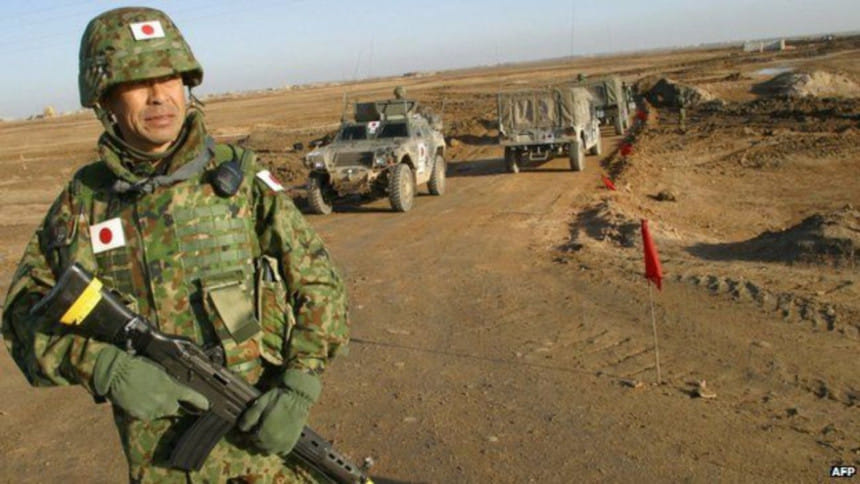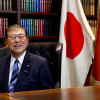Japan picks up sword again after 70 years!

Politics in the Far East region is getting interesting by the day with ample hints that it would get complicated soon with some new developments in the region. Perhaps the biggest development till date is the passing of the security bill in the powerful lower house of Japan parliament allowing changes in the 70-year-old policy of pacifism.
The newly adopted security bill would now allow Japanese forces to arm themselves like any modern armed forces of the world and fight against foreign troops at home and abroad, if and when required. Japanese Prime Minister had to face tough opposition in parliament to get the bill through but finally he could convince others that in view of the fast-changing geo-political realities, especially those in the Far East region, Japan needed to be militarily stronger to face any eventuality.
Hence, we hear the faint rattling of sabers, as the long swords that Japan had laid down after the defeat in WWII, have been picked up once again to send a message to the world.
What happened 70 years ago?
When Japan was defeated in the WWII in 1945 by the allied forces in the eastern theatre, Emperor Hirohito had laid down his royal sword in surrender. In fact, the wide-ranging devastation caused by the dropping of atomic bombs on Hiroshima and Nagasaki had hastened the Emperor to take the decision despite opposing views among many of his war-mongering ministers. The surrender was announced by Imperial Japan on August 15 and instruments of surrender were formally signed on September 2, 1945.
We may take a look at some of the terms and conditions laid
down in the Instrument of Surrender.
"We hereby command all Japanese forces wherever situated and the Japanese people to cease hostilites forthwith, to preserve and save from damage all ships, aircraft, and military and civil property and to comply with all requirements which may be imposed by the Supreme Commander for the Allied Powers or by agencies of the Japanese Government at his direction...."
(The last paragraph reads):
"The authority of the Emperor and the Japanese Government to rule the state shall be subject to the Supreme Commander for the Allied Powers who will take such steps as he deems proper to effectuate these terms of surrender. "
Signed at TOKYO BAY, JAPAN at 0904 I on the SECOND day of SEPTEMBER, 1945
(Source: Surrender by Japan: Terms between the United States of America and the Other Allied Powers and Japan. Department of State Publication 2504, Executive Agreement Series 493.)
After the surrender, the battle-weary Emperor of Japan vowed to follow a policy of non-aggression and concentrated on rebuilding the country from ashes. It was a daunting task for the war ravaged nation. Instead of focusing on building up a massive armed forces, Japan pursued a policy of developing its education, science and technology, healthcare system, medicine, engineering, agriculture and so on. Within the next twenty years or so, Japan turned around dramatically, becoming a developed country with a booming economy.
No, the surrender of Japan did not end the monstrosity called war. In the last 70 years, the world has seen many more bloody wars in Asia, Central Asia, the Middle East, Europe and Africa. The Korean War, the Vietnam War, the wars in the Balkans and those in the Middle East caused deaths, destruction and displacement of millions. Intermittent wars destroyed the economy of countless number of countries caught in the fray. But Japan stayed far away from these wars.
Why then does Japan need to be martial once again? Political analysts would be quick to give the example of China, which is growing fast into an economic giant in the region. Though there is no overt enmity between the two countries, many analysts feel there is an undercurrent of mistrust and competition that may influence their policies. The issue of establishing control over the East and South-China Sea for strategic reasons and to enjoy the resources is a dominant factor in this case.
The prestigious magazine The Diplomat writes: "In the recently-released "Defense of Japan" white paper, Japan's Ministry of Defense had a lot to say about China as a security threat. In one of the more specific criticisms, the paper takes China to task for its "unilateral development" work in the East China Sea, where Japan and China have not yet delimited their exclusive economic zones (EEZs), thanks in part to an on-going territorial dispute over the Senkaku/Diaoyu Islands. In recent months, similar accusations have mostly been leveled at China with regards to its activities in the South China Sea, especially its land reclamation and island-building activities. The paper specifically mentions China's construction of offshore gas platforms in the East China Sea, a project started in June 2013. Japan believes the construction work is in violation of a 2008 agreement that would have Japan and China jointly develop natural resources in the East China Sea."
Japan also has an issue with Russia over the disputed Kuril Islands. While Russia took control of the islands after WWII, Tokyo considers itself as the rightful owner of the South Kurils – comprising Kunashir, Shikotan, Iturup and the Habomai Rocks. The decades-long dispute has prevented Moscow and Tokyo from signing a formal peace treaty to recognise the end of their hostilities, following the end of World War II. While the issue remains a politically charged subject in Japan, former Russian president Dmitry Medvedev had categorically said, "This is our land and military forces should be deployed there since this is the border."
As said in the beginning, the Far East has all the potential to become even more interesting any time. Japan is probably better able to perceive its position in the future world and is taking preparations to dig trenches well in advance.
The writer is Special Supplements Editor, The Daily Star.

 For all latest news, follow The Daily Star's Google News channel.
For all latest news, follow The Daily Star's Google News channel. 








Comments